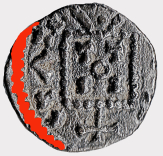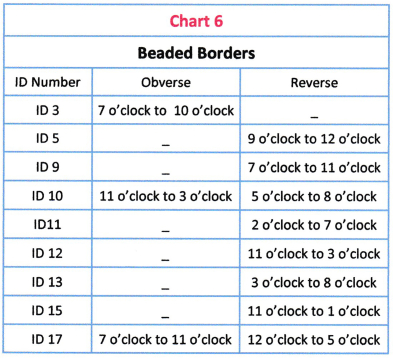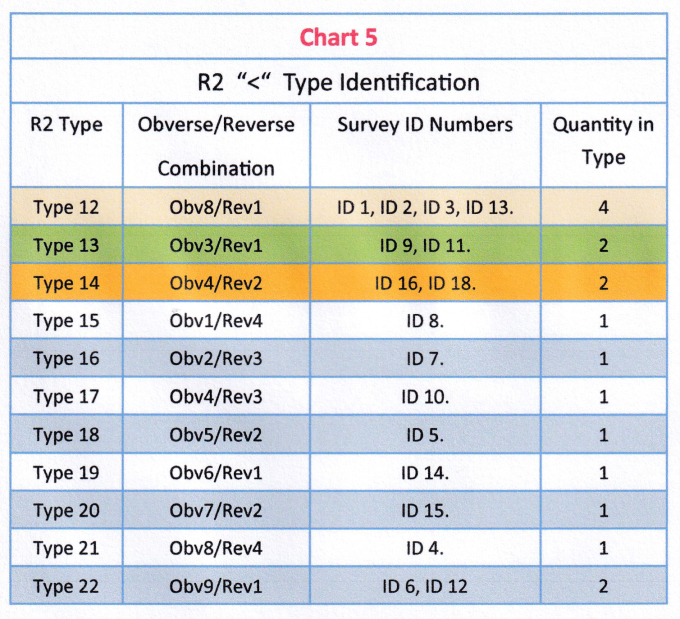Runic Series Sceatta Classification
R Series Type 2


To the left is a "Diagram" of how the runes
EPA appear on the Sceatta. They are preceded by a "T" and also sometimes followed by another "T". The "T's" always have the top of the letter pointing outwards
and the runes always point inwards.
R2 Type 12 “Plus” Comparision
These notes compare the various Metcalf “Type 12” R2 Sceatta and Gannon “Group 2, Ʌ facing inwards” (637-39) Plate 27, Sceatta. In his work “Runic Sceattas Reading EPA, Types R1 and R2” (2007), Metcalf classifies Sceatta with the “<“ (unbarred horizontal A) behind the head pointing away from the head on the obverse as “Type 12”. This is the only type of all of the 12 types with the symbol < pointing this way. Gannon’s work “British Museum Sylloge 63” is more recent, 2013, this however, only documents two coins of this type.
However, as with the Types 1 to 11, there are many variations of additional symbols on both the obverse and the reverse of the Type 12 in my collection and that are recorded on the Fitzwilliam’s EMC database, in Gannon’s Sylloge 63, in Metcalf’s Thrymsas & Sceattas vol 3 and in Dr T Abramson’s collection. I have used images from these four sources and from my collection for this study. This study includes only 18 coins with the < pointing away from the head.
On some flans the strike shows an unbarred “A” and sometimes an “A” with an angled cross piece. Some of the “I’s” are much more waisted than others, the same applies to the “T’s”. It is usual that the symbols/letters are mirrored on each side of the Standard. I have recorded the letters/symbols in a clockwise direction from the top of the flan on both the obverse and reverse of the coins. I have closely examined, on the R2 coins I have and other images, the symbols on the outside of the standard on the reverse of the coins. The 45° angled lines in each corner of the standard do not appear to be attached to the standard, I have therefore considered them to be symbols/letters rather than corner lines as in the later coins of the R series.
In Thyrmsas & Sceattas in the Ashmolean Museum Oxford Vol. 3 Plate 23 394/395 Metcalf shows the two images of R2 coins, 394 clearly shows the < pointing away from the head, although not so clear I think that the < on 395 is also pointing the same way.
In Sylloge 63 Gannon describes three R2 coins, Plate 27, 637/638/639 as having the Runes {TEPA 637} {EPA 638} {TEPA 639}. Although 638 is listed as having the runes EPA I believe that the bottom of a “T” can be seen above the “E” rune.
In "Sceatta List" p64 Abramson identifies the Runes as TWPA. However the Runes on the R2 series have the tops of the letters pointing inwards giving the “E” (which looks like a upper case M) appearance of being a W.
In “Runic Sceattas Reading EPA, Types R1 and R2”, Metcalf lists under the Type 12 coins (and presumably therefore R2’s) 35, 36, 37, 38, 40, 41, 42, and 43. With the exception of 43 all have the “<“ behind and pointing away from the head. Gannon uses the classification of “Busts with pyramidal neck” Sylloge 63, 627-639.
There are many variations of symbols within the types 1 to 11, as further coins are being found with yet more variations, does the range of types extend further than the “Type 12”?
Most (17 of the 18) coins observed appear to have the runes/symbols TEPA in front of the head. On coins with the ID’s 3, 9 and 13 the “T” is not clear. On coin ID 17 the runes are not clear at all. ID 8 runes may have a “T” before them. Defining characteristics for inclusion of coins in this survey are therefore:-
All of the Obverses have:-
1) A horizontal barred “A” behind and pointing away from the head
2) The Runes EPA preceded by a “T”
3) The Runes read clockwise from “12 o’clock”
4) The top of the Runes all point INWARDS, the letter “T” OUTWARDS
5) A crowned head facing right
All of the Reverses have:-
1) A beaded Standard
2) A Tufa (Fantail) on the top of the Standard
3) A cross Pommėe on the bottom mid point outside of the Standard
4) Two “T’s” and two vertical “I’s” around a central annulet within the Standard
5) “Letters” to right and left outside of the Standard
Weights
Four “Horned Standard coins” ID 5 1.23g, ID 16 1.29g, ID 17 1.22 and ID 19 1.21g have a median weight of 1.2375g. The other coins (2 coins no weight given) have a median weight of = 1.076g. Non-horned only 87% weight of horned. Horned weigh 115% more. Gannon, in Sylloge 63, mentions the possibility of a horn on the right side of the standard on coin ID14 (638), on close examination at high magnification I don’t think that the mark is a horn.
Find Spots
There 18 coins with 10 different counties listed. Four coins do not have a recorded find spot. There are no recorded find spots in the North West of England. Most of the coins with a recorded find spot are either in “East Anglia” or adjoin it. Essex, Suffolk, Norfolk and Lincolnshire account for 6 of the 14 known locations.
Essex 2
Lincolnshire 2
Oxfordshire 2
North Yorkshire 2
East Sussex 1
Hampshire 1
Norfolk 1
North Somerset 1
Northamptonshire 1
Suffolk 1
No Find Spot 4
Obverse
All coins have a three pointed “triangle” crown, each triangle containing a pellet. There is usually a continuous line below the crown and a beaded line between that and the head. All have a beaded pyramidal neck of four lines and two pellets as lips. The majority of the coins have three exergual lines, the top and bottom usually continuous and the middle beaded.
Coin ID 11 has four pellets joining the two Ʌ’s behind the head, it also has four pellets clearly visible below the three exergual lines. Coins ID 8 and ID 18 may also have four pellets below the lines, but these are not clear. On some coins this is clear on the obverse and some on the reverse.
There are a variety of symbols/letters behind the head on the obverse. TAT is most common but additional “I’s” can also be found. A cross above the A can also be seen on a few. On most coins the “Bar” on the “A” is fairly clear, however on coin ID 10 and ID 17 it is not at all clear. Coin ID 18 does not appear to have a bar even under high magnification. Very high magnification is needed on some coins to be able to see the bar.
Runes epa are preceded by a T. On ID 3 the “T” is not at all clear and on ID 8 does not appear to be there at all. On some coins there appears to be something after the a rune, ID 15 is the only coin where this appears to clearly be a small “T”. Is this the case with all coins having a “letter” after the last rune?
Reverse
All coins have the symbols etc shown in the photo above. These consist of a beaded standard topped by a tufa containing three pellets. Projecting out wards from the bottom of the standard is a large cross. Within the standard are two “T’s” above a central annulet, below the annulet are two vertical ”I’s”.
There are a variety of letter combinations of “I’s”, “T’s” and unbarred “A’s”. These are mirrored on each side of the standard. They read clockwise (from 12 o’clock) being interrupted by the cross at the bottom of the coin (6 o’clock). I have counted the angled “I’s” as letters as they are not joined to the standard as in the later “R” series coins and do not always appear at the corners of the standard.
Four coins ID 5, 16, 17 and 19, have “sloping horns” hanging down outside from the top line of the beaded standard. These “horns” also appear on the Series “A”, Series “Ci” and “R” Series R5 s p i (SPI) Sceatta.
Some coins have a beaded border, coins ID 10 and ID 17 appear to have a border visible on both the obverse and reverse of the flan, ID 3 has one on the obverse only. Coins ID 5, ID 9, ID 11, ID 12, ID 13 and ID 15 have a visible beaded border on part of the flan on the reverse only. Borders are much more obvious on coins with an offset strike. Borders can be seen on 50% of coins.

ID 9 Beaded Border left in red.
Approximately from
7 o’clock to 11 o’clock.

The coins are shown with the Tufa on top of the standard, at the top of the picture. There is a variety of Die Axis differences, where these are recorded (12 coins) they are given as 0° (4 coins), 45° (1 coin), 90° (3 coins), 180° (2 coins) and 270° (2 coins). Six coins have no recorded die axis.
Obverse Runes
The two main combinations of runes are TEPA and what I think is the bottom of another “T” following the “A” rune TEPAT. This is very evident with the coin ID 15 where the flan encompasses the whole strike. In the other group nothing can be seen following the last rune. “T’s” are not shown as an Anglo Saxon Runic T but as we would write now. All of the runes and letters have endings in the Pattėe style.
Type Allocation
I have observed all of the different aspects of the iconography of both the obverse and reverse of the 18 coins in the survey. Using the criteria mentioned previously I have allocated a “Type” number to each group of coins with similar iconography or individual coins that are unique.

See page "Type 12 to Type 16" for details about those Types,
and page "Type 17 to Type 22" for details about those Types.





